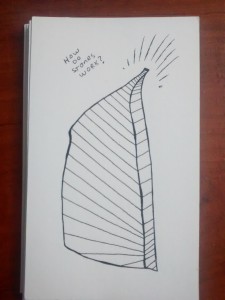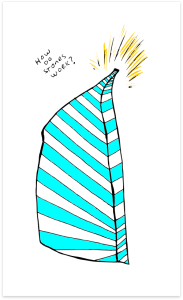I’ve been thinking about process lately. Okay, I’ve honestly been thinking about process for years. I’ve figured out pieces of my own process over the years through trial and error, reading about other processes, and dumb luck. What I’m most interested in now is how to increase the likelihood of using my own process to the extent that it is identified at the present moment.
It seems that the best way to improve the use of my own best―at the moment―process will be removing the barriers that hinder continuing or discourage even starting. I’ve identified the primary barrier as the mess of a work area I’ve used through the birth of two children and a PhD[1. if you’re interested you can read my dissertation here]. It’s a tick above freezing in the winter and a constant mess. Home sweet home. The image above is a real shot of my desk without any pre-photo cleaning (promise). What is missing is the disarray around and beneath and before the desk. I grow anxious just walking into the space.
What is surprising is how much and how little work I’ve put into the arrangement seen above. The 2×4’s serve the dual-purpose of raising the monitor to eye-level and providing a handy space for the keyboard to reside when desk- space is at a premium. Unfortunately I rarely use that latter, pre-planned feature. The keyboard is central to my workflow even when using the Wacom tablet to create or edit pixels and vectors. The hard drive to the right of the under-used notebooks is meant for backups but mostly holds older copies of things I already have newer live copies of (or, worse still, holds unnecessary copies of copies).
It turns out that I’m a little afraid to even go through the work of cleaning off the hard drive for fear of getting lost in what has become a truly ubiquitous time-capsule of everything (instead of just what was deemed to be most important). Fear, in fact, motivates much of my trepidation approaching the cleaning of the desk and the surrounding areas. But fear of what?
time
Time is what I most fear losing. The reframe is simple: I lose time anyway. I wish just saying that you lose time anyway was more motivating. Alas, the human mind is not always rational. Such is life. I find it difficult to get certain things done for fear of losing the time spent getting them done. I might have done something more productive than the thing I’m confident would help most in the future. Again, brains are weird. My poor brain doesn’t want to lose time (that it will “lose” anyway).
I know this is imprudent. That’s the whole reason I’m writing about it. I’m spending unnecessary time on something less productive to fully explore how productive just doing things can be when you just start. And this is a key factor I’ve discovered over the years about myself―
I’m more productive when I’m less efficient.
This sounds either unbelievably stupid or oddly profound. I wish it was wrong. I wish that I could endlessly be driven by efficiency improvements iterated over a lifetime. No matter―the slow way is the productive and efficient way for me. And slow involves some uncomfortable (for me) friends―mainly paper.
paper
I desperately want to like all digital technologies, but I like what I like despite all efforts so far. Paper is the main friend that I’m embarrassed to profit from greatly. Paper―despite what I and many others think―is a technology. It’s hard to think of it as such since it’s not battery-powered. This lack of battery is a feature, not a bug. Recognizing the technology aspect of paper is an important reframe for me as it places paper on the same level as other more interesting and distracting technologies. And this is the core struggle because I’ve known forever that paper makes me more productive (while seemingly less efficient). I hate taking the non-digital step in an ultimately digital process. The problem is that if I don’t take the non-digital paper step I don’t get anything done.
Here’s a drawing I did on an index card a while ago.

Listen, I wish I was a better artist but I take that drawing and scan it.

Then I vectorize the image I’ve scanned.

And then I color it and place it back on an index-card-shaped white rectangle floating above the void.

That’s a process that I’m using now. I’m trying to own it as the process I use and not focus on the myriad ways I could get lost trying to improve the speed of the process. It’s like that xkcd comic about time―is it worth it to automate?

For now my answer is no.


Leave a Reply
You must be logged in to post a comment.